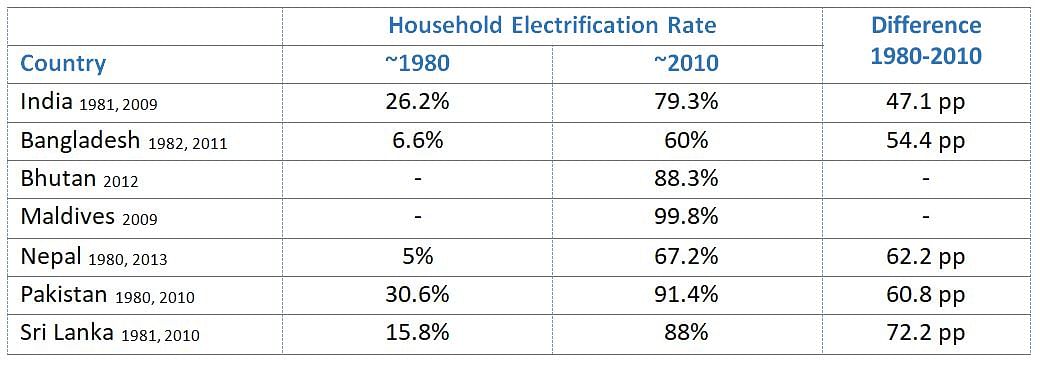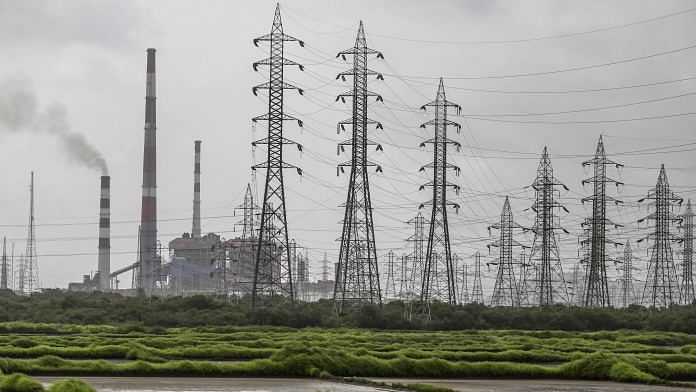Modi’s flagship Saubhagya scheme is completing a decade of intense efforts that started with Manmohan Singh’s aggressive policies.
On 28 April, Prime Minister Narendra Modi announced that the country’s last village without electricity had been electrified. This is a stunning achievement and crowns a decade of efforts. But how does it compare to the rest of South Asia?
New data that we collected for the Initiative for Sustainable Energy Policy (ISEP) show that India’s remarkable progress is part of a broader trend toward universal electrification in the region. Yet that energy access would improve was not a given. It was driven by ambitious and well-designed policies.
Also read: Power distribution companies are slowing down Narendra Modi’s Saubhagya scheme
Broader trend
Our new data show how daunting the problem of electrification was just thirty years ago. Electricity poverty was rampant across South Asia. In India, only 20 per cent of all households (and 15 per cent in rural areas) were connected to the grid. The scale of the problem was staggering.
Yet India has made remarkable progress since then. The latest data suggest that household electrification rates in India have reached about 90 per cent. Beyond the abstract numbers, hundreds of millions of individuals gained access to electric power and the benefits that come with it.
Remarkable as it is, India’s trajectory is closely matched by other countries in South Asia.

Progress happened everywhere (Table 1). Countries such as Sri Lanka (+72 percentage points between 1980 and 2010) or Nepal (+62.2 percentage points) saw national rates increase the most over that period. Rural areas benefitted considerably. In Bhutan, for instance, the rural electrification rate went from 20 per cent in 1995 to 82.6 per cent in 2012 – an increase of more than 60 percentage points in less than twenty years! Thus, after decades of struggles, electrification rapidly reached a majority of households in the entire region.
Table 1: Electrification rates in South Asia around 1980 and 2010.

Table 2: Rural electrification rates in South Asia around 1980, 1995, and 2010.

These numbers put Modi’s recent announcement that “every single village of India now has access to electricity” in context. India’s progress does not stand out in regional comparison. South Asia, in general, has made great strides toward universal electrification.
Yet we shouldn’t downplay India’s achievements. First, India faced a different challenge than some of its neighbours due to the size of its population. Second, the country considerably improved its record since 2010. This was no small feat and is something to celebrate. It also highlights the key ingredient to solving energy woes: ambitious policies.
Ambitious policies key
The data show that such progress did not have to happen. Rural electrification suffered painful setbacks in the 1990s. India itself saw access to electricity slow down, especially in rural areas. We shouldn’t think that the problem was bound to be solved.
Instead, these trajectories should remind us of how important government action is. Take Bangladesh. The Bangladesh rural electrification programme is often lauded as an example of good policymaking. Combining local engagement by customers and light supervision by the government, this programme has provided electricity to millions of households. According to a report by the Bangladesh Rural Electrification Board (BREB), about 3.6 million new users were connected to the grid in 2016-2017, for a total of 11 million consumers added between 2009 and 2017. The BREB claims to have electrified about 74,000 out of 83,000 villages in its programme. Good policy was crucial.
Also read: Dark side of India’s night lights: As states prosper, rich-poor gap in districts widens
The same applies to India. Aggressive policies, starting with Manmohan Singh’s Rajiv Gandhi Grameen Vidyutikaran Yojana (RGGVY) scheme were instrumental in tackling this problem. The Saubhagya scheme, Modi’s flagship electrification programme, is currently completing a decade of intense efforts. In the absence of such ambitious policies, it is likely that the path to universal electrification would have been considerably slower.
What’s next?
Modi’s announcement doesn’t mean that the problem of electricity access has been solved. Challenges still exist.
One problem, widely noted (for instance here or here), is that village electrification does not equate to household electrification. In practice, many household are still off the grid. According to data from Saubhagya, almost 20 million households remain un-electrified. Quick back-of-the-envelope calculations suggest thus that over 100 million people lack access*. Most live in Uttar Pradesh, but other states are affected as well. Overall, twelve states still need to connect over one million individuals each.
Saubhagya is designed to complete the process and provide electricity to all. Will it be able to do so? The pace has certainly been intense, with about 10 million household connected since October 2017. Last August alone, 3 million households were provided with electricity.
Assuming Saubhagya is successful, the government could then turn to the next challenge: improving electricity quality. Connection was the first step. Ultimately, electricity will only improve welfare if it is reliable. Blackouts remain a costly problem for India. The government will need to find ways to improve infrastructures and stabilise distribution companies, which are still bleeding money. The Modi government has plenty of difficult decisions to look forward to. And the same applies to India’s neighbours.
The author is an assistant professor at University of Pittsburgh, US and Initiative for Sustainable Energy Policy (ISEP) fellow.
*To get this number, we multiplied each state’s number of un-electrified households with that same state’s average household size (using 2011 census estimates). Given that most un-electrified households are based in rural areas, where the average household size is larger, it is likely that our estimate understates the problem.



